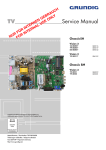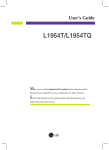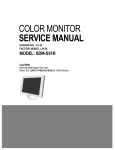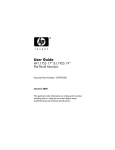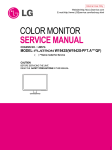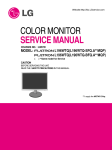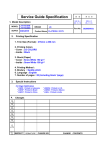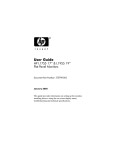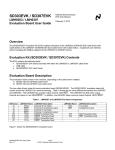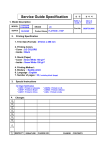Download COLOR MONITOR SERVICE MANUAL
Transcript
Internal Use Only Website:http://biz.LGservice.com COLOR MONITOR SERVICE MANUAL CHASSIS NO. : LM 84B MODEL: ( CAUTION W1952TQ(W1952TQ-PFT.K***A**) ) **Same model for Service BEFORE SERVICING THE UNIT, READ THE SAFETY PRECAUTIONS IN THIS MANUAL. CONTENTS SPECIFICATIONS ................................................... 2 ADJUSTMENT ...................................................... 13 PRECAUTIONS ....................................................... 4 TROUBLESHOOTING GUIDE .............................. 15 TIMING CHART ....................................................... 8 DISASSEMBLY ........................................................ 9 EXPLODED VIEW...................................................19 BLOCK DIAGRAM ................................................. 10 REPLACEMENT PARTS LIST ...............................21 DESCRIPTION OF BLOCK DIAGRAM...................11 SCHEMATIC DIAGRAM ......................................... 23 SPECIFICATIONS 1. LCD CHARACTERISTICS Type : TFT Color LCD Module Active Display Area : 19 inch diagonal Pixel Pitch : 0.285 (H) x 0.285 (V) Size : 493.7(H) x 320.1(V) x 16.5(D) Color Depth : 16.7M colors Electrical Interface : LVDS Surface Treatment : AG(Haze 25%), Hard Coating(3H) Operating Mode : Normally White Backlight Unit : 4 CCFL 4. MAX. RESOLUTION Analog Digital : 1440 x 900@60Hz : 1440 x 900@60Hz 5. POWER SUPPLY 5-1. Power Adaptor(Built-in Power) Input : AC 100-240V~, 50/60Hz, 0.8A 5-2. Power Consumption MODE 2. OPTICAL CHARACTERISTICS 2-1. Viewing Angle by Contrast Ratio ≥5 H/V SYNC VIDEO POWER CONSUMPTION LED COLOR less than 39 W(max) POWER ON (NORMAL) ON/ON ACTIVE less than 36 W(typ) BLUE Left : +80° min., +88°(Typ) Right : -80° min., -88°(Typ) Top : +80° min., +85°(Typ) Bottom : -80° min., -85°(Typ) STAND BY OFF/ON OFF less than 1 W AMBER SUSPEND ON/OFF OFF less than 1 W AMBER 2-2. Luminance DPMS OFF OFF/OFF OFF less than 1 W AMBER less than 1 W OFF 2-3. Contrast Ratio : 180(Typ) (Typ. 30)-sRGB : 210(min), 300(Typ)-6500K : 150(min)-9300K : 500(min), 1000(Typ) DFC -> 10000 : 1 (Typ) POWER S/W OFF 3-3. Operating Frequency Horizontal Vertical : R, G, B Analog : 0~0.7 V : 75 Ω : 28 ~ 83kHz : 56 ~ 75Hz 6-1. Operating Temperature : 10°C~35°C (50°F~95°F) 6-2. Relative Humidity : 10%~80% (Non-condensing) 6-3. MTBF : 50,000 HRS with 90% Confidence level Lamp Life : 40,000 Hours (Min) 7. DIMENSIONS (with TILT/SWIVEL) Width Depth Height : 451.5 mm (17.78'') : 386 mm (15.2'') : 220 mm (8.66'') 8. WEIGHT (with TILT/SWIVEL) Net. Weight Gross Weight Copyright 2007 LG Electronics. Inc. All right reserved. Only for training and service purposes - 6. ENVIRONMENT 3. SIGNAL (Refer to the Timing Chart) 3-1. Sync Signal • Type : Separate Sync, SOG, Digital 3-2. Video Input Signal 1) Type 2) Voltage Level 3) Input Impedance - -2- : 3.9 kg (8.6 lbs) : 5.02 kg (11.07 lbs) LGE Internal Use Only Signal Connector Pin Assignment • DVI-D Connector (Digital) 1 9 17 Pin 1 2 3 4 5 6 7 8 9 10 11 12 13 14 15 8 16 24 Signal (DVI-D) T. M. D. S. Data2T. M. D. S. Data2+ T. M. D. S. Data2/4 Shield T. M. D. S. Data4T. M. D. S. Data4+ DDC Clock DDC Data Analog Vertical Sync. T. M. D. S. Data1T. M. D. S. Data1+ T. M. D. S. Data1/3 Shield T. M. D. S. Data3T. M. D. S. Data3+ +5V Power Ground (return for +5V, Pin 16 17 18 19 20 21 22 23 24 Signal (DVI-D) Hot Plug Detect T. M. D. S. Data0T. M. D. S. Data0+ T. M. D. S. Data0/5 Shield T. M. D. S. Data5T. M. D. S. Data5+ T. M. D. S. Clock Shield T. M. D. S. Clock+ T. M. D. S. Clock- H. Sync. and V. Sync.) T. M. D. S. (Transition Minimized Differential Signaling) Copyright 2007 LG Electronics. Inc. All right reserved. Only for training and service purposes -3- LGE Internal Use Only PRECAUTION WARNING FOR THE SAFETY-RELATED COMPONENT. WARNING • There are some special components used in LCD monitor that are important for safety. These parts are marked on the schematic diagram and the replacement parts list. It is essential that these critical parts should be replaced with the manufacturer’s specified parts to prevent electric shock, fire or other hazard. • Do not modify original design without obtaining written permission from manufacturer or you will void the original parts and labor guarantee. BE CAREFUL ELECTRIC SHOCK ! • If you want to replace with the new backlight (CCFL) or inverter circuit, must disconnect the AC adapter because high voltage appears at inverter circuit about 650Vrms. • Handle with care wires or connectors of the inverter circuit. If the wires are pressed cause short and may burn or take fire. Leakage Current Hot Check Circuit AC Volt-meter TAKE CARE DURING HANDLING THE LCD MODULE WITH BACKLIGHT UNIT. • Must mount the module using mounting holes arranged in four corners. • Do not press on the panel, edge of the frame strongly or electric shock as this will result in damage to the screen. • Do not scratch or press on the panel with any sharp objects, such as pencil or pen as this may result in damage to the panel. Good Earth Ground such as WATER PIPE, CONDUIT etc. To Instrument's exposed METALLIC PARTS 1.5 Kohm/10W • Protect the module from the ESD as it may damage the electronic circuit (C-MOS). • Make certain that treatment person’s body are grounded through wrist band. • Do not leave the module in high temperature and in areas of high humidity for a long time. • The module not be exposed to the direct sunlight. • Avoid contact with water as it may a short circuit within the module. • If the surface of panel become dirty, please wipe it off with a softmaterial. (Cleaning with a dirty or rough cloth may damage the panel.) CAUTION Please use only a plastic screwdriver to protect yourself from shock hazard during service operation. Copyright 2007 LG Electronics. Inc. All right reserved. Only for training and service purposes -4- LGE Internal Use Only SERVICING PRECAUTIONS CAUTION: Before servicing receivers covered by this service manual and its supplements and addenda, read and follow the SAFETY PRECAUTIONS on page 3 of this publication. NOTE: If unforeseen circumstances create conflict between the following servicing precautions and any of the safety precautions on page 3 of this publication, always follow the safety precautions. Remember: Safety First. General Servicing Precautions 1. Always unplug the receiver AC power cord from the AC power source before; a. Removing or reinstalling any component, circuit board module or any other receiver assembly. b. Disconnecting or reconnecting any receiver electrical plug or other electrical connection. c. Connecting a test substitute in parallel with an electrolytic capacitor in the receiver. CAUTION: A wrong part substitution or incorrect polarity installation of electrolytic capacitors may result in an explosion hazard. d. Discharging the picture tube anode. 2. Test high voltage only by measuring it with an appropriate high voltage meter or other voltage measuring device (DVM, FETVOM, etc) equipped with a suitable high voltage probe. Do not test high voltage by "drawing an arc". 3. Discharge the picture tube anode only by (a) first connecting one end of an insulated clip lead to the degaussing or kine aquadag grounding system shield at the point where the picture tube socket ground lead is connected, and then (b) touch the other end of the insulated clip lead to the picture tube anode button, using an insulating handle to avoid personal contact with high voltage. 4. Do not spray chemicals on or near this receiver or any of its assemblies. 5. Unless specified otherwise in this service manual, clean electrical contacts only by applying the following mixture to the contacts with a pipe cleaner, cottontipped stick or comparable non-abrasive applicator; 10% (by volume) Acetone and 90% (by volume) isopropyl alcohol (90%-99% strength) CAUTION: This is a flammable mixture. Unless specified otherwise in this service manual, lubrication of contacts in not required. 6. Do not defeat any plug/socket B+ voltage interlocks with which receivers covered by this service manual might be equipped. 7. Do not apply AC power to this instrument and/or any of its electrical assemblies unless all solid-state device heat sinks are correctly installed. 8. Always connect the test receiver ground lead to the receiver chassis ground before connecting the test receiver positive lead. Always remove the test receiver ground lead last. Copyright 2007 LG Electronics. Inc. All right reserved. Only for training and service purposes 9. Use with this receiver only the test fixtures specified in this service manual. CAUTION: Do not connect the test fixture ground strap to any heat sink in this receiver. Electrostatically Sensitive (ES) Devices Some semiconductor (solid-state) devices can be damaged easily by static electricity. Such components commonly are called Electrostatically Sensitive (ES) Devices. Examples of typical ES devices are integrated circuits and some field-effect transistors and semiconductor "chip" components. The following techniques should be used to help reduce the incidence of component damage caused by static by static electricity. 1. Immediately before handling any semiconductor component or semiconductor-equipped assembly, drain off any electrostatic charge on your body by touching a known earth ground. Alternatively, obtain and wear a commercially available discharging wrist strap device, which should be removed to prevent potential shock reasons prior to applying power to the unit under test. 2. After removing an electrical assembly equipped with ES devices, place the assembly on a conductive surface such as aluminum foil, to prevent electrostatic charge buildup or exposure of the assembly. 3. Use only a grounded-tip soldering iron to solder or unsolder ES devices. 4. Use only an anti-static type solder removal device. Some solder removal devices not classified as "antistatic" can generate electrical charges sufficient to damage ES devices. 5. Do not use freon-propelled chemicals. These can generate electrical charges sufficient to damage ES devices. 6. Do not remove a replacement ES device from its protective package until immediately before you are ready to install it. (Most replacement ES devices are packaged with leads electrically shorted together by conductive foam, aluminum foil or comparable conductive material). 7. Immediately before removing the protective material from the leads of a replacement ES device, touch the protective material to the chassis or circuit assembly into which the device will be installed. CAUTION: Be sure no power is applied to the chassis or circuit, and observe all other safety precautions. 8. Minimize bodily motions when handling unpackaged replacement ES devices. (Otherwise harmless motion such as the brushing together of your clothes fabric or the lifting of your foot from a carpeted floor can generate static electricity sufficient to damage an ES device.) -5- LGE Internal Use Only General Soldering Guidelines 1. Use a grounded-tip, low-wattage soldering iron and appropriate tip size and shape that will maintain tip temperature within the range or 500 F to 600 F. 2. Use an appropriate gauge of RMA resin-core solder composed of 60 parts tin/40 parts lead. 3. Keep the soldering iron tip clean and well tinned. 4. Thoroughly clean the surfaces to be soldered. Use a mall wire-bristle (0.5 inch, or 1.25cm) brush with a metal handle. Do not use freon-propelled spray-on cleaners. 5. Use the following unsoldering technique a. Allow the soldering iron tip to reach normal temperature. (500 F to 600 F) b. Heat the component lead until the solder melts. c. Quickly draw the melted solder with an anti-static, suction-type solder removal device or with solder braid. CAUTION: Work quickly to avoid overheating the circuitboard printed foil. 6. Use the following soldering technique. a. Allow the soldering iron tip to reach a normal temperature (500 F to 600 F) b. First, hold the soldering iron tip and solder the strand against the component lead until the solder melts. c. Quickly move the soldering iron tip to the junction of the component lead and the printed circuit foil, and hold it there only until the solder flows onto and around both the component lead and the foil. CAUTION: Work quickly to avoid overheating the circuit board printed foil. d. Closely inspect the solder area and remove any excess or splashed solder with a small wire-bristle brush. IC Remove/Replacement Some chassis circuit boards have slotted holes (oblong) through which the IC leads are inserted and then bent flat against the circuit foil. When holes are the slotted type, the following technique should be used to remove and replace the IC. When working with boards using the familiar round hole, use the standard technique as outlined in paragraphs 5 and 6 above. Removal 1. Desolder and straighten each IC lead in one operation by gently prying up on the lead with the soldering iron tip as the solder melts. 2. Draw away the melted solder with an anti-static suction-type solder removal device (or with solder braid) before removing the IC. Copyright 2007 LG Electronics. Inc. All right reserved. Only for training and service purposes Replacement 1. Carefully insert the replacement IC in the circuit board. 2. Carefully bend each IC lead against the circuit foil pad and solder it. 3. Clean the soldered areas with a small wire-bristle brush. (It is not necessary to reapply acrylic coating to the areas). "Small-Signal" Discrete Transistor Removal/Replacement 1. Remove the defective transistor by clipping its leads as close as possible to the component body. 2. Bend into a "U" shape the end of each of three leads remaining on the circuit board. 3. Bend into a "U" shape the replacement transistor leads. 4. Connect the replacement transistor leads to the corresponding leads extending from the circuit board and crimp the "U" with long nose pliers to insure metal to metal contact then solder each connection. Power Output, Transistor Device Removal/Replacement 1. Heat and remove all solder from around the transistor leads. 2. Remove the heat sink mounting screw (if so equipped). 3. Carefully remove the transistor from the heat sink of the circuit board. 4. Insert new transistor in the circuit board. 5. Solder each transistor lead, and clip off excess lead. 6. Replace heat sink. Diode Removal/Replacement 1. Remove defective diode by clipping its leads as close as possible to diode body. 2. Bend the two remaining leads perpendicular y to the circuit board. 3. Observing diode polarity, wrap each lead of the new diode around the corresponding lead on the circuit board. 4. Securely crimp each connection and solder it. 5. Inspect (on the circuit board copper side) the solder joints of the two "original" leads. If they are not shiny, reheat them and if necessary, apply additional solder. Fuse and Conventional Resistor Removal/Replacement 1. Clip each fuse or resistor lead at top of the circuit board hollow stake. 2. Securely crimp the leads of replacement component around notch at stake top. 3. Solder the connections. CAUTION: Maintain original spacing between the replaced component and adjacent components and the circuit board to prevent excessive component temperatures. -6- LGE Internal Use Only Circuit Board Foil Repair Excessive heat applied to the copper foil of any printed circuit board will weaken the adhesive that bonds the foil to the circuit board causing the foil to separate from or "lift-off" the board. The following guidelines and procedures should be followed whenever this condition is encountered. At IC Connections To repair a defective copper pattern at IC connections use the following procedure to install a jumper wire on the copper pattern side of the circuit board. (Use this technique only on IC connections). 1. Carefully remove the damaged copper pattern with a sharp knife. (Remove only as much copper as absolutely necessary). 2. carefully scratch away the solder resist and acrylic coating (if used) from the end of the remaining copper pattern. 3. Bend a small "U" in one end of a small gauge jumper wire and carefully crimp it around the IC pin. Solder the IC connection. 4. Route the jumper wire along the path of the out-away copper pattern and let it overlap the previously scraped end of the good copper pattern. Solder the overlapped area and clip off any excess jumper wire. Copyright 2007 LG Electronics. Inc. All right reserved. Only for training and service purposes At Other Connections Use the following technique to repair the defective copper pattern at connections other than IC Pins. This technique involves the installation of a jumper wire on the component side of the circuit board. 1. Remove the defective copper pattern with a sharp knife. Remove at least 1/4 inch of copper, to ensure that a hazardous condition will not exist if the jumper wire opens. 2. Trace along the copper pattern from both sides of the pattern break and locate the nearest component that is directly connected to the affected copper pattern. 3. Connect insulated 20-gauge jumper wire from the lead of the nearest component on one side of the pattern break to the lead of the nearest component on the other side. Carefully crimp and solder the connections. CAUTION: Be sure the insulated jumper wire is dressed so the it does not touch components or sharp edges. -7- LGE Internal Use Only TIMING CHART VIDEO A E D SYNC mode 1 2 3 4 5 6 7 8 9 10 11 12 13 14 15 16 B C section polarity H(Pixels) + V(Lines) - H(Pixels) - V(Lines) + H(Pixels) - V(Lines) - H(Pixels) - V(Lines) - H(Pixels) + V(Lines) + H(Pixels) + V(Lines) + H(Pixels) +/ - V(Lin es) +/ - H(Pixels) - V(Lines) - H(Pixels) - V(Lines) - H(Pixels) +/ - V(Lines) +/ - H(Pixels) +/ - V(Lines) +/ - H(Pixels) + V(Lines) + H(Pixels) + V(Lines) + H(Pixels) + V(Lines) - H(Pixels) - V(Lines) + H(Pixels) - V(Lines) + DOT Frequency CLOCK [MHz] [kHz]/[Hz] 25.175 28.321 25.175 31.5 40.0 49.5 57.283 65.0 78.75 100.0 92.978 108.0 135.0 88.750 106.500 136.750 Copyright 2007 LG Electronics. Inc. All right reserved. Only for training and service purposes 31.469 Total Display Front Sync. Back Porch(D) (C) Porch(B) Resolution Period (E) (A) 800 640 16 96 48 70.09 449 350 37 2 60 31.468 900 720 18 108 54 70.08 449 400 12 2 35 31.469 800 640 16 96 48 59.94 525 480 10 2 33 37.5 840 640 16 64 120 75 500 480 1 3 16 37.879 1056 800 40 128 88 60.317 628 600 1 4 23 46.875 1056 800 16 80 160 75.0 625 600 1 3 21 49.725 1152 832 32 64 224 74.55 667 624 1 3 39 48.363 1344 1024 24 136 160 60.0 806 768 3 6 29 60.123 1312 1024 16 96 176 75.029 800 768 1 3 28 68.681 1456 1152 32 128 144 75.062 915 870 3 3 39 61.805 1504 1152 18 134 200 65.96 937 900 2 4 31 63.981 1688 1280 48 112 248 60.02 1066 1024 1 3 38 79.976 1688 1280 16 144 248 75.035 1066 1024 1 3 38 55.5 1600 1440 48 32 80 59.90 926 900 3 6 17 55.935 1904 1440 80 152 232 59.887 934 900 3 6 25 70.635 1936 1440 96 152 248 74.984 942 900 3 6 33 -8- 640 x 350 720 x 400 640 x 480 640 x 480 800 x 600 800 x 600 832 x 624 1024 x 768 1024 x 768 1152 x 870 1152 x 900 1280 x 1024 1280 x 1024 1440 x 900 1440x 900 1440x 900 LGE Internal Use Only DISASSEMBLY 1. Put a cushion or soft cloth on a flat surface. 2. Place the monitor face down on the cushion or soft cloth. 3. Slide the Cable Deco Cover out from the stand body. 4. 5. Please pull the stand body lightly to separate it from the hinge body. Press the hook,Take off the stand base from stand body. 6. Remove the screws. 7. Pull the front cover upward,then separate all the latches. 8. Place the monitor face down,then disassemble back cover. -9 - D-Sub DVI-D Copyright 2007 LG Electronics. Inc. All right reserved. Only for training and service purposes Filter EEPROM (EDID) - 10 - 15V Inverter(4Lamps) LIPS DVI(TMDS) EEPROM (EDID) Analog I(R/G/B) 15V 5V 1.8V 3.3V OSD 5V Regulator 3.3V EEPROM (System) SDA /SCL Dual Interface Engine Display Processing Engine 1.8V 3.3V 14.318MHz Crystal Clock Generator DRAM Response Time Enhancement LVDS Vcc 5V 3.3V Flash ROM MCU LVDS Panel Interface 1680X1050@60Hz 146Mhz Module KEY TSUMO58CWHJ BLOCK DIAGRAM LGE Internal Use Only DESCRIPTION OF BLOCK DIAGRAM 1. Video Controller Part. This part amplifies the level of video signal for the digital conversion and converts from the analog video signal to the digital video signal using a pixel clock. The pixel clock for each mode is generated by the PLL. The range of the pixel clock is 136MHz In W1952TQ. This part consists of the Scaler, ADC convertor, TMDS receiver and LVDS transmitter. The Scaler gets the video signal converted analog to digital, interpolates input to 1440X900(W1952TQ) resolution signal and outputs 8-bit R, G, B signal to transmitter. 2. Power Part. This part consists of the one 3.3V, and one 1.8V regulators to convert power which is provided 5V in Power board. 15V is provided for inverter in W1952TQ. Also, 5V is converted 3.3V and 1.8V by regulator. Converted power is provided for IC in the main board. The inverter converts from DC 15V to AC 700Vrms and operates back-light lamps of module in W1952TQ. 3. MICOM Part. This part is include video controller part. And this part consists of EEPROM IC , control data, Reset IC and the Micom. The Micom distinguishes polarity and frequency of the H/V sync are supplied from signal cable. The controlled data of each modes is stored in EEPROM. Copyright 2007 LG Electronics. Inc. All right reserved. Only for training and service purposes - 11 - LGE Internal Use Only LIPS Board Block Diagram 15V 50 ~ 60Hz EMI COMPONENTS INPUT RECTIFIER AND FILTER HVDC ENERGY TRANSFER 67KHz OUTPUT RECTIFIER AND FILTER 5V GND LINE 100 ~ 240V PWM CONTROL CIRCUIT SIGNAL COLLENTION PHOTOCOUPLER ISOLATION PRIMARY SECONDARY Operation description_Power 1. EMI components. This part contains of EMI components to comply with global marketing EMI standards like FCC,VCCI CISPR, the circuit included a line-filter, across line capacitor and of course the primary protection fuse. 2. Input rectifier and filter. This part function is for transfer the input AC voltage to a DC voltage through a bridge rectifier and a bulk capacitor. 3. Energy Transfer. This part function is for transfer the primary energy to secondary through a power transformer. 4. Output rectifier and filter. This part function is to make a pulse width modulation control and to provide the driver signal to power switch, to adjust the duty cycle during different AC input and output loading condition to achieve the dc output stabilized, and also the over power protection is also monitor by this part. 5. Photo-Coupler isolation. This part function is to feed back the DC output changing status through a photo transistor to primary controller to achieve the stabilized DC output voltage. 6. Signal collection. This part function is to collect the any change from the DC output and feed back to the primary through photo transistor. Copyright 2007 LG Electronics. Inc. All right reserved. Only for training and service purposes - 12 - LGE Internal Use Only ADJUSTMENT Windows EDID V1.0 User Manual 2. EDID Read & Write 1) Run WinEDID.exe Operating System: MS Windows 98, 2000, XP Port Setup: Windows 98 => Doesn’t need setup Windows 2000, XP => Need to Port Setup. This program is available for LCD Monitor only. 1. Port Setup a) Copy “UserPort.sys” file to “c:\WINNT\system32\drivers” folder b) Run Userport.exe 2) Edit Week of Manufacture, Year of Manufacture, Serial Number a) Input User Info Data b) Click “Update” button c) Click “ Write” button c) Remove all default number d) Add 300-3FF e) Click Start button. f) Click Exit button. Copyright 2007 LG Electronics. Inc. All right reserved. Only for training and service purposes - 13 - LGE Internal Use Only SERVICE OSD 1) Turn off the power switch at the right side of the display. 2) Wait for about 5 seconds and press MENU, POWER switch for 1 second interval. 3) The SVC OSD menu contains additional menus that the User OSD menu as described below. a) CLEAR ETI : To initialize using time. c) Auto Color : W/B balance and Automatically sets the gain and offset value. (press key for over 3 sec) d) AGING : Select Aging mode(on/off). b) Module : To select applied module. d) NVRAM INIT : EEPROM initialize.(24C16, press key for over 3 sec) e) R/G/B-9300K : Allows you to set the R/G/B-9300K value manually. f) R/G/B-6500K : Allows you to set the R/G/B-6500K value manually. g) R/G/B-Offset : Allows you to set the R/G/B-Offset value manually.(Analog Only) h) R/G/B-Gain : Allows you to set the R/G/B-Gain value manually.(Analog Only) A IBM Compatible PC Video Signal Generator 9 15 10 5 11 6 1 6 1 5 C 13 RS 23 2C 5V LE L OFF 14 ON F Power inlet (required) 5V 4.7K 4.7K 220 A Power Select Switch (110V/220V) Power LED PO WE R VG S MO NI TO R V-S YN CS T C 1 25 PA RA L Control Line No t us ed PARALLEL PORT ON E 5V 4.7K OFF 74LS06 74LS06 B E ST Switch B F V-Sync On/Off Switch (Switch must be ON.) Figure 1. Cable Connection Copyright 2007 LG Electronics. Inc. All right reserved. Only for training and service purposes - 14 - LGE Internal Use Only TROUBLESHOOTING GUIDE 1. NO POWER NO POWER (POWER INDICATOR OFF) 1 CHECK P704 VOLTAGE PIN5, PIN6 (5V)? CHECK POWER BOARD, AND FIND OUT A SHORT POINT AS OPENING EACH POWER LINE NO YES 2 3 1 IS IC703 PIN2(3.3V) IC702 PIN2(1.8V) NO CHECK IC703(3.3V) IC702(1.8V) LINE YES 4 1 CHECK U501 PIN127 PULSE NO CHECK CRYSTAL(X501) YES CHECK U501 Waveforms 1 P704-#5,6 2 IC703-#2 Copyright 2007 LG Electronics. Inc. All right reserved. Only for training and service purposes 3 - 15 - IC702-#2 4 U501-#127 LGE Internal Use Only 2. NO RASTER (OSD IS NOT DISPLAYED) – LIPS NO RASTER (OSD IS NOT DISPLAYED) 1 CHECK P704 VOLTAGE PIN5,6 (5V)? NO CHECK POWER BOARD (LIPS) YES NO 2 CHECK U501 INVERTER ON/OFF PORT P704 PIN9 3.3V? YES 1. CONFIRM BRIGHTNESS OSD CONTRL STATUS 2. CHECK MICOM DIM-ADJ PORT NO 3 CHECK P704 PIN10 YES 4 CHECK PULSE AS CONTACTING PROBE TO THE LAMP WIRE OF THE LCD MODULE NO POWER BOARD (LIPS) Waveforms YES 1 P704-#5,6 2 P704-#9 3 P704-#10 (Brightness 0) 5 LAMP CURRENT REPLACE LCD MODULE 3 P704-#10 (Brightness 100) Copyright 2007 LG Electronics. Inc. All right reserved. Only for training and service purposes - 16 - LGE Internal Use Only 3. NO RASTER (OSD IS NOT DISPLAYED) - MAIN NO RASTER (OSD IS NOT DISPLAYED) CHECK U501 PIN114(3.3V) PIN21(1.8V) NO CHECK IC703(3.3V), IC702(1.8V) YES U501 PIN 127,128 14.3MHZ? 1 NO 1. CHECK PIN 127,128 SOLDERING CONDITION 2. CHECK X501 3. TROUBLE IN U501 YES CHECK U501 PIN32(H-SYNC) AND PIN33(V-SYNC). IS PULSE APPEARED AT SIGNAL PINS? NO CHECK CONNECTION LINE FROM D-SUB TO U501 YES TROUBLE IN CABLE OR LCD MODULE Waveforms 1 U501-#127 Copyright 2007 LG Electronics. Inc. All right reserved. Only for training and service purposes - 17 - LGE Internal Use Only 4. TROUBLE IN DPM TROUBLE IN DPM NO CHECK R717 AND R718, SYNC APPEARED? CHECK PC PC IS GOING INTO DPM MODE YES 1 2 CHECK U501 PIN 32,33 SYNC PULSE NO CHECK H/V SYNC LINE YES TROUBLE IN U501 Waveforms 1 H-SYNC 2 V-SYNC Copyright 2007 LG Electronics. Inc. All right reserved. Only for training and service purposes - 18 - LGE Internal Use Only 930 920 900 500 510 400 410 430 910 420 200 300 Copyright 2007 LG Electronics. Inc. All right reserved. Only for training and service purposes LGE Internal Use Only EXPLODED VIEW PARTS LIST Ref. No. Part No. EAJ41390301 LCD,Module-TFT,HT190WG1-100 ZBD DRIVER 19.0INCH 1440X900 300CD COLOR 72% 16/9 700:1 4CCFL, 160/160, 5ms BOE HYDIS TECHNOLOGY LCD,Module-TFT,LM190WX1-TLC2 DRIVER 19INCH 1440X900 300CD COLOR 72% 16/10 850:1 P7, 5ms,Non-ZBD,MAGNA source D-IC, OKI gate D-IC, TLI T-con, 160/160 LG PHILIPS LCD LCD,Module-TFT,M190A1-L07 Non-ZBD WXGA 19INCH 1440X900 380CD COLOR 72% 16/10 1000:1 CMO 19"W WXGA+,Non-ZBD,Non-Glare, TN, 16.7M, Response time:5ms,Viewing angle:170/ LCD,Module-TFT,M190PW01-V0 DRIVER 19INCH 1440X900 300CD COLOR 72% 16/10 800:1 5MS, 2CH-LVDS, 160/160, 4LAMP, NON-ZBD AU OPTRONICS CORP LCD,Module-TFT,M190MWW1 Non-ZBD WXGA 19INCH 1440X900 300CD COLOR 72% 16/10 800:1 5ms, 16.2M, TN,160/160(CR=10), For Only China domestic market SVA MTD SVA190WX02TB WXGA 19INCH 1440X900 300CD COLOR 72% 16/10 800:1 SVA-NEC 19"W WXGA+,ZBD,Color Gamut 16.77M,6bit+HiFRC,Response time 5ms,LVDS 2port,Viewin ABJ35702302 Cabinet Assembly,W1952 S 19" CABINET ASSY FOR LPL/CMO/MTD ABJ35702304 Cabinet Assembly,W1952 S 19" CABINET ASSY, 02 CKD ABJ36830002 Cabinet Assembly,W1952 CABINET ASSY FOR AUO/BOE/NEC/CMO+ EAJ35661001 EAJ36290802 EAJ42097502 200 EAJ32175201 EAJ38022802 300 400 410 420 Description ACQ35704405 Cover Assembly,Rear,W1952 S 19" W1952 BACKCOVER ACQ35704407 Cover Assembly,Rear,W1952 S 19" W1952 BACKCOVER AGF35751203 Package Assembly,MAIN W52 series ODC Mstar MGJ41193201 Plate,Shield,PRESS SPTE 0.3 SHIELD SPTE 0.3T, Lamp Shield, L1755/W1952/W2252 MGJ41193202 Plate,Shield,PRESS SPTE 0.3 SHIELD SPTE 0.3T, Lamp Shield, L1755/W1952/W2252 MGJ41204901 Plate,Metal,PRESS SBHG 0.8T SUPPORTER EGI W1952 METAL SUPPORT EGI 0.8T 430 MGJ41204902 Plate,Metal,PRESS SBHG 0.8T SUPPORTER EGI W1952 METAL SUPPORT EGI 0.8T MGJ41204903 Plate,Metal,PRESS SBHG 0.8T SUPPORTER EGI W1952 METAL SUPPORT EGI 0.8T 500 EBR42021801 PCB Assembly,LED & P/SW T.T LM84 W52 series - - 510 EBR41684101 PCB Assembly,CONTROL T.T LM84A W52 series RD - 900 910 920 930 ACQ33707101 Cover Assembly,L1954T LM57B 19" Cover, Hinge Assy, Normal Stand, L1954T ACQ33707107 Cover Assembly,L1954T,L207W LM57B 20" Cover, Hinge Assy Normal Stand, 01-CKD MCK41193001 Cover,MOLD ABS L1755/WX52 ABS HF 350, Stand Body(L1755/WX52) MCK41193003 Cover,MOLD ABS L1755/WX52 ABS HF 350, Stand Body(L1755/WX52) BLACK CKD MCK41193101 Cover,MOLD ABS L1755/WX52 ABS HF 350, Cover Cable MCK41193103 Cover,MOLD ABS L1755/WX52 ABS HF 350, Cover Cable Black CKD AAN35706801 Base Assembly,STAND W1952, W2252 - W1952, W2252 stand base assy AAN35706802 Base Assembly,STAND W1952, W2252 - W1952, W2252 stand base assy Copyright 2007 LG Electronics. Inc. All right reserved. Only for training and service purposes - 20 - LGE Internal Use Only REPLACEMENT PARTS LIST DATE:2007.11.20 LOC NO. PART NO. DESCRIPTION/SPECIFICATON CAPACITORs C501 C502 C503 C504 C505 C506 C507 C508 C509 C510 C511 C512 C513 C514 C515 C516 C517 C518 C519 C520 C521 C522 C523 C524 C525 C526 C527 C528 C529 C530 C531 C532 C533 C534 C535 C536 C537 C538 C539 C540 C541 C700 C701 C702 C703 C704 C705 C706 C707 C708 C709 C710 C711 C712 C713 C714 C715 C716 C717 C719 C720 C722 C723 C725 0CK104CF56A 0CK473CH56A 0CK473CH56A 0CK473CH56A 0CK473CH56A 0CC102CK41A 0CK473CH56A 0CK473CH56A 0CC270CK41A 0CC270CK41A 0CK103CK51A 0CK103CK51A 0CK104CF56A 0CK224CF56A 0CE106CF638 0CK104CF56A 0CK104CF56A 0CK104CF56A 0CK104CF56A 0CK104CF56A 0CK104CF56A 0CK104CF56A 0CK104CF56A 0CK104CF56A 0CK104CF56A 0CK104CF56A 0CK104CF56A 0CK104CF56A 0CK104CF56A 0CK104CF56A 0CK104CF56A 0CK104CF56A 0CK104CF56A 0CK104CF56A 0CK104CF56A 0CK104CF56A 0CK104CF56A 0CK104CF56A 0CC080CK11A 0CC080CK11A 0CC080CK11A 0CC101CK41A 0CC101CK41A 0CC680CK41A 0CK104CK56A 0CC680CK41A 0CK104CF56A 0CK104CF56A 0CK104CF56A 0CK104CF56A 0CK104CF56A 0CK104CF56A 0CK104CF56A 0CK104CF56A 0CC680CK41A 0CC680CK41A 0CK104CF56A 0CK104CF56A 0CK104CF56A 0CK104CF56A 0CK475CC94A 0CK103CK51A 0CE107EF610 0CE107EF610 “Capacitor,Ceramic,Chip,0603B104K160CT 100nF” “Capacitor,Ceramic,Chip,C1608X7R1E473KT 47nF” “Capacitor,Ceramic,Chip,C1608X7R1E473KT 47nF” “Capacitor,Ceramic,Chip,C1608X7R1E473KT 47nF” “Capacitor,Ceramic,Chip,C1608X7R1E473KT 47nF” “Capacitor,Ceramic,Chip,C1608C0G1H102JT 1nF” “Capacitor,Ceramic,Chip,C1608X7R1E473KT 47nF” “Capacitor,Ceramic,Chip,C1608X7R1E473KT 47nF” “Capacitor,Ceramic,Chip,C1608C0G1H270JT 27pF” “Capacitor,Ceramic,Chip,C1608C0G1H270JT 27pF” “Capacitor,Ceramic,Chip,0603B103K500CT 10nF” “Capacitor,Ceramic,Chip,0603B103K500CT 10nF” “Capacitor,Ceramic,Chip,0603B104K160CT 100nF” “Capacitor,Ceramic,Chip,0603B224K160CT 220nF” “Capacitor,AL,Radial,SHL5.0TP16VB10M 10uF” “Capacitor,Ceramic,Chip,0603B104K160CT 100nF” “Capacitor,Ceramic,Chip,0603B104K160CT 100nF” “Capacitor,Ceramic,Chip,0603B104K160CT 100nF” “Capacitor,Ceramic,Chip,0603B104K160CT 100nF” “Capacitor,Ceramic,Chip,0603B104K160CT 100nF” “Capacitor,Ceramic,Chip,0603B104K160CT 100nF” “Capacitor,Ceramic,Chip,0603B104K160CT 100nF” “Capacitor,Ceramic,Chip,0603B104K160CT 100nF” “Capacitor,Ceramic,Chip,0603B104K160CT 100nF” “Capacitor,Ceramic,Chip,0603B104K160CT 100nF” “Capacitor,Ceramic,Chip,0603B104K160CT 100nF” “Capacitor,Ceramic,Chip,0603B104K160CT 100nF” “”Capacitor,Ceramic,Chip,0603B104K160CT 100nF” “Capacitor,Ceramic,Chip,0603B104K160CT 100nF” “Capacitor,Ceramic,Chip,0603B104K160CT 100nF” “Capacitor,Ceramic,Chip,0603B104K160CT 100nF” “Capacitor,Ceramic,Chip,0603B104K160CT 100nF” “Capacitor,Ceramic,Chip,0603B104K160CT 100nF” “Capacitor,Ceramic,Chip,0603B104K160CT 100nF” “Capacitor,Ceramic,Chip,0603B104K160CT 100nF” “Capacitor,Ceramic,Chip,0603B104K160CT 100nF” “Capacitor,Ceramic,Chip,0603B104K160CT 100nF” “Capacitor,Ceramic,Chip,0603B104K160CT 100nF” “Capacitor,Ceramic,Chip,C1608C0G1H080DT 8pF” “Capacitor,Ceramic,Chip,C1608C0G1H080DT 8pF” “Capacitor,Ceramic,Chip,C1608C0G1H080DT 8pF” “Capacitor,Ceramic,Chip,C1608C0G1H101JT 100p” “Capacitor,Ceramic,Chip,C1608C0G1H101JT 100p” “Capacitor,Ceramic,Chip,C1608C0G1H680JT 68pF” “Capacitor,Ceramic,Chip,0603B104K500CT 100nF” “Capacitor,Ceramic,Chip,C1608C0G1H680JT 68pF” “Capacitor,Ceramic,Chip,0603B104K160CT 100nF” “Capacitor,Ceramic,Chip,0603B104K160CT 100nF” “Capacitor,Ceramic,Chip,0603B104K160CT 100nF” “Capacitor,Ceramic,Chip,0603B104K160CT 100nF” “Capacitor,Ceramic,Chip,0603B104K160CT 100nF” “Capacitor,Ceramic,Chip,0603B104K160CT 100nF” “Capacitor,Ceramic,Chip,0603B104K160CT 100nF” “Capacitor,Ceramic,Chip,0603B104K160CT 100nF” “Capacitor,Ceramic,Chip,C1608C0G1H680JT 68pF” “Capacitor,Ceramic,Chip,C1608C0G1H680JT 68pF” “Capacitor,Ceramic,Chip,0603B104K160CT 100nF” “Capacitor,Ceramic,Chip,0603B104K160CT 100nF” “Capacitor,Ceramic,Chip,0603B104K160CT 100nF” “Capacitor,Ceramic,Chip,0603B104K160CT 100nF” “Capacitor,Ceramic,Chip,C1608Y5V0J475ZT 4.7u” “Capacitor,Ceramic,Chip,0603B103K500CT 10nF” “Capacitor,AL,Radial,KMG16VB100M 100uF 20” “Capacitor,AL,Radial,KMG16VB100M 100uF 20” LOC NO. PART NO. DESCRIPTION/SPECIFICATON C726 C727 C728 C729 C730 C731 C732 C733 C734 C738 C739 C740 C780 0CE107EF610 0CE107EF610 0CK105CD56A 0CK105CD56A 0CK105CD56A 0CK102CK56A 0CK102CK56A 0CK102CK56A 0CE107EF610 0CK104CF56A 0CK105CD56A 0CC101CK41A 0CE106CF638 “Capacitor,AL,Radial,KMG16VB100M 100uF 20” “Capacitor,AL,Radial,KMG16VB100M 100uF 20” “Capacitor,Ceramic,Chip,C1608X7R1A105KT 1uF” “Capacitor,Ceramic,Chip,C1608X7R1A105KT 1uF” “Capacitor,Ceramic,Chip,C1608X7R1A105KT 1uF” “Capacitor,Ceramic,Chip,0603B102K500CT 1nF 1” “Capacitor,Ceramic,Chip,0603B102K500CT 1nF 1” “Capacitor,Ceramic,Chip,0603B102K500CT 1nF 1” “Capacitor,AL,Radial,KMG16VB100M 100uF 20” “Capacitor,Ceramic,Chip,0603B104K160CT 100nF” “Capacitor,Ceramic,Chip,C1608X7R1A105KT 1uF” “Capacitor,Ceramic,Chip,C1608C0G1H101JT 100p” “Capacitor,AL,Radial,SHL5.0TP16VB10M 10uF” D700 D701 D702 D703 D704 D705 D706 D707 D708 D709 D710 D711 D712 ZD10 ZD700 ZD701 ZD702 ZD703 ZD704 ZD707 ZD708 ZD709 ZD9 0DSIH00018A 0DSIH00018A 0DSIH00018A 0DSIH00018A 0DSIH00018A 0DSIH00018A 0DSIH00018A 0DSIH00018A 0DSIH00018A 0DSIH00018A 0DSIH00018A 0DSON00138A 0DD184009AA 0DZ560009GB 0DZ560009GB 0DZ560009GB 0DZ560009GB 0DZ560009GB 0DZ560009GB 0DZ560009GB 0DZ560009GB 0DZ560009GB 0DZ560009GB “Diode,Switching,ENKMC2837-T112 1.2V” “Diode,Switching,ENKMC2837-T112 1.2V” “Diode,Switching,ENKMC2837-T112 1.2V” “Diode,Switching,ENKMC2837-T112 1.2V” “Diode,Switching,ENKMC2837-T112 1.2V” “Diode,Switching,ENKMC2837-T112 1.2V” “Diode,Switching,ENKMC2837-T112 1.2V” “Diode,Switching,ENKMC2837-T112 1.2V” “Diode,Switching,ENKMC2837-T112 1.2V” “Diode,Switching,ENKMC2837-T112 1.2V” “Diode,Switching,ENKMC2837-T112 1.2V” “Diode,Schottky,MMBD301LT1G 600MV 30” “Diode Assembly,KDS184 KDS184 TP KEC” “Diode,Zener,BZT52C5V6S-(F) 5.6V” “Diode,Zener,BZT52C5V6S-(F) 5.6V” “Diode,Zener,BZT52C5V6S-(F) 5.6V” “Diode,Zener,BZT52C5V6S-(F) 5.6V” “Diode,Zener,BZT52C5V6S-(F) 5.6V” “Diode,Zener,BZT52C5V6S-(F) 5.6V” “Diode,Zener,BZT52C5V6S-(F) 5.6V” “Diode,Zener,BZT52C5V6S-(F) 5.6V” “Diode,Zener,BZT52C5V6S-(F) 5.6V” “Diode,Zener,BZT52C5V6S-(F) 5.6V” IC700 IC702 IC703 U501 U502 U503 0IMMR00014A 0IPMG78403A 0IPMGA0010A 0IPRP00784C EAN37157001 0IMMRSG036B “IC,EEPROM,M24C02-RMN6TP 2KBIT” “IC,LDO Voltage Regulator,AZ1086S-1.8TRE1 3.2T” “IC,LDO Voltage Regulator,AZ1117H-3.3 4.75TO10” “IC,Video Processors,FE253MOH-LF 300MVTO3” “IC,Serial Flash Memory,W25X20VSNIG 2MBIT 25” “IC,EEPROM,M24C16-WMN6TP 16KBIT” L700 L701 L702 0LCML00003B 0LCML00003B 0LCML00003B “Filter,Bead,MLB-201209-0120P-N2” “Filter,Bead,MLB-201209-0120P-N2” “Filter,Bead,MLB-201209-0120P-N2” Q501 Q700 Q701 Q705 Q706 Q707 Q760 Q761 0TRKE80046A 0TRKE80046A EBK39150701 0TRKE80046A 0TR390609DC 0TR390609DC 0TR390609DC 0TRKE80046A “TR,Bipolar,2N3904S NPN 6V 60V 4” “TR,Bipolar,2N3904S NPN 6V 60V 4” “TR,Bipolar,KTA1241 PNP -8V -35V” “TR,Bipolar,2N3904S NPN 6V 60V 4” “TR,Bipolar,2N3906S-RTK PNP -5V” “TR,Bipolar,2N3906S-RTK PNP -5V” “TR,Bipolar,2N3906S-RTK PNP -5V” “TR,Bipolar,2N3904S NPN 6V 60V 4” R1 R2 R3 0RJ1602D677 0RJ1602D677 0RJ1801D677 “Resistor,Chip,MCR03EZPJ163 16KOHM” “Resistor,Chip,MCR03EZPJ163 16KOHM” “Resistor,Chip,MCR03EZPJ182 1.8KOHM” DIODEs ICs FILTERs TRANSISTORs RESISTORs - 21 - LOC NO. R4 R5 R501 R502 R503 R504 R505 R506 R507 R508 R509 R510 R511 R512 R513 R514 R516 R517 R518 R519 R520 R521 R522 R523 R524 R525 R526 R527 R530 R6 R700 R701 R702 R703 R704 R705 R706 R707 R708 R709 R711 R712 R713 R715 R716 R717 R718 R719 R720 R721 R723 R725 R726 R727 R728 R729 R730 R731 R734 R735 R749 R750 R751 R752 R753 R754 R755 R758 PART NO. 0RJ1801D677 0RJ2201D677 0RJ1000D677 0RJ0562D677 0RJ1000D677 0RJ0562D677 0RJ4700D677 0RJ1000D677 0RJ0562D677 0RJ4701D677 0RJ4701D677 0RJ4701D677 0RJ4701D677 0RJ4700D677 0RJ4700D677 0RJ0000D677 0RJ3900D677 0RJ1002D677 0RJ1000D677 0RJ1502D677 0RJ0000D677 0RJ0000D677 0RJ4701D677 0RJ1000D677 0RJ1002D677 0RJ4701D677 0RJ0332D677 0RJ0332D677 0RJ1002D677 0RJ2201D677 0RJ4701D677 0RJ4701D677 0RJ0332D677 0RJ0102D677 0RJ0102D677 0RJ0102D677 0RJ0102D677 0RJ0102D677 0RJ0102D677 0RJ0332D677 0RJ0102D677 0RJ0102D677 0RJ1001D677 0RJ0332D677 0RJ0752D677 0RJ0682D677 0RJ0682D677 0RJ0332D677 0RJ0752D677 0RJ0752D677 0RJ3601D677 0RJ1002D677 0RJ3900D677 0RJ1002D677 0RJ3900D677 0RJ4701D677 0RJ4701D677 0RJ4701D677 0RX0331K668 0RH1002D622 0RJ2001D677 0RJ2700D677 0RJ2700D677 0RJ1000D677 0RJ1000D677 0RJ0000D677 0RJ1001D677 0RJ4701D677 DESCRIPTION/SPECIFICATON “Resistor,Chip,MCR03EZPJ182 1.8KOHM” “Resistor,Chip,MCR03EZPJ222 2.2KOHM” “Resistor,Chip,MCR03EZPJ101 100OHM” “Resistor,Chip,MCR03EZPJ560 56OHM 5” “Resistor,Chip,MCR03EZPJ101 100OHM” “Resistor,Chip,MCR03EZPJ560 56OHM 5” “Resistor,Chip,MCR03EZPJ471 470OHM” “Resistor,Chip,MCR03EZPJ101 100OHM” “Resistor,Chip,MCR03EZPJ560 56OHM 5” “Resistor,Chip,MCR03EZPJ472 4.7KOHM” “Resistor,Chip,MCR03EZPJ472 4.7KOHM” “Resistor,Chip,MCR03EZPJ472 4.7KOHM” “Resistor,Chip,MCR03EZPJ472 4.7KOHM” “Resistor,Chip,MCR03EZPJ471 470OHM” “Resistor,Chip,MCR03EZPJ471 470OHM” “Resistor,Chip,MCR03EZPJ000 0OHM 5%” “Resistor,Chip,MCR03EZPJ391 390OHM” “Resistor,Chip,MCR03EZPJ103 10KOHM” “Resistor,Chip,MCR03EZPJ101 100OHM” “Resistor,Chip,MCR03EZPJ153 15KOHM” “Resistor,Chip,MCR03EZPJ000 0OHM 5%” “Resistor,Chip,MCR03EZPJ000 0OHM 5%” “Resistor,Chip,MCR03EZPJ472 4.7KOHM” “Resistor,Chip,MCR03EZPJ101 100OHM” “Resistor,Chip,MCR03EZPJ103 10KOHM” “Resistor,Chip,MCR03EZPJ472 4.7KOHM” “Resistor,Chip,MCR03EZPJ330 33OHM 5” “Resistor,Chip,MCR03EZPJ330 33OHM 5” “Resistor,Chip,MCR03EZPJ103 10KOHM” “Resistor,Chip,MCR03EZPJ222 2.2KOHM” “Resistor,Chip,MCR03EZPJ472 4.7KOHM” “Resistor,Chip,MCR03EZPJ472 4.7KOHM” “Resistor,Chip,MCR03EZPJ330 33OHM 5” “Resistor,Chip,MCR03EZPJ100 10OHM 5” “Resistor,Chip,MCR03EZPJ100 10OHM 5” “Resistor,Chip,MCR03EZPJ100 10OHM 5” “Resistor,Chip,MCR03EZPJ100 10OHM 5” “Resistor,Chip,MCR03EZPJ100 10OHM 5” “Resistor,Chip,MCR03EZPJ100 10OHM 5” “Resistor,Chip,MCR03EZPJ330 33OHM 5” “Resistor,Chip,MCR03EZPJ100 10OHM 5” “Resistor,Chip,MCR03EZPJ100 10OHM 5” “Resistor,Chip,MCR03EZPJ102 1KOHM 5” “Resistor,Chip,MCR03EZPJ330 33OHM 5” “Resistor,Chip,MCR03EZPJ750 75OHM 5” “Resistor,Chip,MCR03EZPJ680 68OHM 5” “Resistor,Chip,MCR03EZPJ680 68OHM 5” “Resistor,Chip,MCR03EZPJ330 33OHM 5” “Resistor,Chip,MCR03EZPJ750 75OHM 5” “Resistor,Chip,MCR03EZPJ750 75OHM 5” “Resistor,Chip,MCR03EZPJ362 3.6KOHM” “Resistor,Chip,MCR03EZPJ103 10KOHM” “Resistor,Chip,MCR03EZPJ391 390OHM” “Resistor,Chip,MCR03EZPJ103 10KOHM” “Resistor,Chip,MCR03EZPJ391 390OHM” “Resistor,Chip,MCR03EZPJ472 4.7KOHM” “Resistor,Chip,MCR03EZPJ472 4.7KOHM” “Resistor,Chip,MCR03EZPJ472 4.7KOHM” “Resistor,Metal Oxide Film,RSD02F4J3R30 3.3OHM” “Resistor,Chip,MCR10EZHJ103 10KOHM” “Resistor,Chip,MCR03EZPJ202 2KOHM 5” “Resistor,Chip,MCR03EZPJ271 270OHM” “Resistor,Chip,MCR03EZPJ271 270OHM” “Resistor,Chip,MCR03EZPJ101 100OHM” “Resistor,Chip,MCR03EZPJ101 100OHM” “Resistor,Chip,MCR03EZPJ000 0OHM 5%” “Resistor,Chip,MCR03EZPJ102 1KOHM 5” “Resistor,Chip,MCR03EZPJ472 4.7KOHM” LOC NO. PART NO. DESCRIPTION/SPECIFICATON R759 R760 R761 R762 R766 R767 R768 R769 R773 R8 0RJ4701D677 0RJ2001D677 0RJ4701D677 0RJ4701D677 0RJ1002D677 0RJ1001D677 0RJ1000D677 0RJ0000D677 0RJ2001D677 0RJ2701D677 “Resistor,Chip,MCR03EZPJ472 4.7KOHM” “Resistor,Chip,MCR03EZPJ202 2KOHM 5” “Resistor,Chip,MCR03EZPJ472 4.7KOHM” “Resistor,Chip,MCR03EZPJ472 4.7KOHM” “Resistor,Chip,MCR03EZPJ103 10KOHM” “Resistor,Chip,MCR03EZPJ102 1KOHM 5” “Resistor,Chip,MCR03EZPJ101 100OHM” “Resistor,Chip,MCR03EZPJ000 0OHM 5%” “Resistor,Chip,MCR03EZPJ202 2KOHM 5” “Resistor,Chip,MCR03EZPJ272 2.7KOHM” P1 P2 P3 P700 P701 P702 P704 P705 6602T12005E 6602T12005C 6602T12005C 6630TGA005B 6630G100316 6630V90220E 6630V90220K EAG37060101 “Connector,Wafer,12505WR-06A00 6P 1.2” “Connector,Wafer,12505WR-04A00 4P 1.2” “Connector,Wafer,12505WR-04A00 4P 1.2” “Connector,DSUB,QH11121-DN0-D DVI 24” “Connector,DSUB,DZ11AA1-HVG-PF D-SUB” “Connector,Wafer,TJC2004-6A 6P 2.0MM” “Connector,Wafer,TJC2004-11A 11P 2.0M” “Connector,FFC/FPC/PIC,10031HR-30 30P 1.00M” SW1 SW2 SW3 SW4 SW5 SW6 SW7 EBF37991701 EBF37991701 EBF37991701 EBF37991701 EBF37991701 EBF37991701 6600R000133 “Switch,Tact,KMB-903/TMB-901 1C1P” “Switch,Tact,KMB-903/TMB-901 1C1P” “Switch,Tact,KMB-903/TMB-901 1C1P” “Switch,Tact,KMB-903/TMB-901 1C1P” “Switch,Tact,KMB-903/TMB-901 1C1P” “Switch,Tact,KMB-903/TMB-901 1C1P” “Switch,Tact,JTP1280A6 1C1P 12VDC” LD2 X501 0DLGP0128AA 6212AA2001G “LED,Chip,GPTD1210YBC BLUE/YEL” “Crystal,HLX-U-F-14.31818M-18” CONNECTORs SWITCHs OTHERs - 22 - SCHEMATIC DIAGRAM 1. SCALER Copyright 2007 LG Electronics. Inc. All right reserved. Only for training and service purposes - 23 - LGE Internal Use Only 2. POWER & WAFER Copyright 2007 LG Electronics. Inc. All right reserved. Only for training and service purposes - 24 - LGE Internal Use Only 3. CONTROL LED Copyright 2007 LG Electronics. Inc. All right reserved. Only for training and service purposes - 25 - LGE Internal Use Only P/NO : MFL30290856 Nov. 2007 Printed in China



























